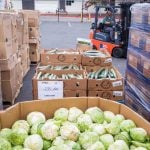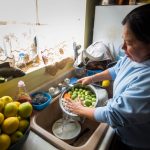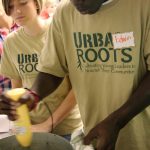Urban Roots (UR) began as a program of Youth Launch in 2008. After an affluent start to the 21st Century, 2008 was not a great year to start a business or non-profit in the US. But it turned out to be great timing for a youth-based urban production farm project in Austin. You see, despite the national economic downturn, Austin was experiencing a decade’s worth of growth that was only curbed by the recession. And while this economic climate provided a solid backdrop for the founding and flourishing of this particular food justice non-profit, it brings up some increasingly common questions about urban food systems, food security organizations and how they fit into gentrifying urban environments.
By the late 2000s, Austin had the momentum of a decade of unprecedented growth that had established it as a cultural and economic hub for Texas. Between 2000 and 2010, Austin’s population expanded by roughly 20%. Much of that growth stemmed from young professionals who brought along their trademark accessories: new/improved housing, higher rents, artisanal cuisine, renovated infrastructure like parks, bike lanes and greenways, high-tech software jobs. In a word, gentrification.
But Austin was different from the other ten fastest growing cities during that time in one crucial factor: it was the only city to suffer a net loss in its African-American population. While the greater population of Austin grew during the 2000s, the African-American population declined by 5.4%. A simplified version of a deeply complex issue can attribute the loss to a number of factors.
Following the encouragement of the city’s Master Plan of 1928, Austin’s African-American population had concentrated in neighborhoods on the city’s east side. Families owned homes and developed businesses. As more wealth moved into the city during the gentrification of the late 90s and 2000s, east-side neighborhoods became attractive for new arrivals. Property values increased and African-American homeowners were enticed to sell.
But other factors attributed to this shift, as well. Many feel that excessive force from police could have played a role. Of the ten unarmed civilians killed by police between 2002 and 2012, seven were African-American, two were Hispanic, and one was white, despite a disproportionately lower overall African-American population in the city. Furthermore, the school system suffered, partly due to an Austin Independent School District (AISD) policy that allowed for private fundraising to be allocated to specific school districts, thus digging a deeper moat between wealthy neighborhoods and the historically segregated lower-income ones, such as east Austin.
All this is to say that Urban Roots came onto the scene in Austin during a time of great opportunity and great need. The food scene was gentrifying along with real estate. Boutique food trucks sprouted like wildflowers below the shady oak trees of downtown’s bungalow neighborhoods. Relocated chefs raised the bar of pub food and Tex-Mex. The local food movement had arrived – the food publication Edible Austin launched and farmers markets became cool again, only this time a bit more pricey than their truck farm predecessors.
Urban Roots did not originate as a response to gentrification, but these rapidly changing socio-economics defined the landscape in which Urban Roots began, thanks to a three-year USDA Community Food Project grant. Max Elliot, executive director and co-founder, wanted to build on the existing youth job skills and service organization, Youth Launch. Elliot saw a radical theory of change in Youth Launch’s approach: engaging young people in long-term, group-based service through paid internships. Urban Roots would add food and sustainable agriculture to that structure. By the time Youth Launch shut its doors in 2011 Urban Roots was already up and running, grounded in its four pillars: service, life-job skills, healthy lifestyles and sustainable agriculture.
Urban Roots aims to use the lessons of a healthy food economy to teach youth job skills and life lessons through service on its 3.5 acre urban farm and at the organization’s farmer’s markets. They donate 40% of their produce to a local soup kitchen and food pantry program and distribute the other 60% through the farmer’s market, CSA and wholesale.
The Urban Roots farm is located in east Austin, the side of town most susceptible to the gentrification creeping out from the urban center. Urban Roots youth are not exclusively from east Austin; they are geographically and racially diverse, though a majority come from households that qualify for free/reduced lunches and many are east Austin residents.
Breez jumped at the chance to work in the challenging, diverse realm of food growing, food marketing and community service. He grew up in east and south Austin, moving often. With Urban Roots he found himself learning a skill and a subject that connected him to people from across the city.Breez Smith found Urban Roots through his high school, Gonzalo Garza Independent High School. Smith was seventeen, coming out of a crazy, drug-riddled part of his life. He arrived late to an outreach meeting at the high school led by Urban Roots’ Max Elliot. Smith was immediately drawn to Elliot’s passion for food and his program that offered a paid job and high school credit while working outside on a farm.
“I’d never eaten many vegetables before Urban Roots,” says Smith. “It opened my mind up in that way. We can all connect through food. There’s always someone in every family – a grandma, maybe – who’d grown food, so you can talk to people about it.”
The Urban Roots youth internship also exposed Smith and his fellow interns to the wider realm of Austin. Smith had seen the effects of gentrification. Just recently, his friend’s grandmother’s house was razed, replaced by a parking garage. “That house had all the history and now it’s used seven hours a day for cars,” he laments. “I can see both sides. It’s bringing money to the area, but it’s detrimental to the people who’ve been there to stick around as the city built up. Two or three years ago, people were afraid to go to east Austin. Now they’re moving in.”
“One organization can’t necessarily stem the tide of gentrification,” says Max Elliot. “That’s a wildfire created by conditions set in place decades ago. Some of our young people that we work with are getting priced out of this community. What might happen is that our farm might be too close in and the youth that we’re meant to serve will be forced further into the suburbs.”
Elliot is cautious in speaking about gentrification. He is white. Most of the board is white. Years ago, Elliot was the only white staff member. Now, the majority of staff is white. It’s hard to say whether that’s a reflection of the overall Austin trend or just the winds of change that blow through any company or non-profit community outreach program. Urban Roots was founded after a rigorous, patient assessment directed by a diverse advisory council from the community: local educators, farmers, hunger advocates and a public health officer. It listened to the neighborhood voice and identified partners that aligned with Urban Root’s four pillars.
“Our farm location is removed from the urban farm nexus in east Austin,” says Elliot. “So we’re not necessarily in the heart of the gentrification at this point. The surge of interest in local food benefits us in the big picture – it brings more people to our farm for tours led by our youth and it brings more people to our farmers market, also staffed by our youth.”
That experience goes beyond participating in growing food. It’s about gaining the social and emotional skills vital to success in school and beyond.
A program like Urban Roots can take advantage of a burgeoning high-end food movement as they work with a low-income community of youth. Breez Smith remembers big-time chefs visiting the farm for workshops, nutritionists offering classes, and his internship has led to an environmental education job and a position with a company designing disaster relief shelters.
“I remember moments when we’d lead farm tours for visitors. We were able to impart knowledge onto a doctor who had no idea about growing food. Even if just a handful of the kids in the program get that sense of leadership, then that ripples out into the community. Another buddy of mine from the program, we’re in a hip-hop group and we’ve got tons of opportunities to spread knowledge in the community. There’s a lot of momentum to spread this word about getting healthy. We grew something like 35,000 pounds of food in a few months! It’s beautiful and it all happens out there with the bugs and the dirt!”
Programs like Urban Roots can find themselves operating in a tense zone. There can be mixed messages around this new food movement, especially at graying socio-economic boundaries. All local food is not always just food. The disparities between the hobbyist community gardens and boutique food trucks serving farm-fresh wraps in one neighborhood and the social justice programs trying to incorporate sustainable food and healthy diets into a youth empowerment program in an adjacent neighborhood illuminate a major challenge for places like Austin where a lot of change is happening at a very fast rate.
“I’m very careful of the messages we use around the youth,” says Elliot. “If we start to say the only way to go is the local food system, that the industrialized food system is bad, then we create a sense of inadequacy for our youth interns if they are dependent on non-local food in their homes. The last thing we want to do is to force beliefs onto young people. The power comes from their experiences and from the inspiration our youth can bring to the community and the local food movement happening within the Urban Roots setting.”
“We are more than a food organization,” Elliot continues. “We want to build healthy food ambassadors and we use food as a tool to give youth voice, confidence, 21st Century job skills and an ability to articulate their experience.”For Elliot, Smith and the Urban Roots crew, seeing that disparity between the food worlds happens at every farmers market when the Urban Roots youth staff sell vegetables they’ve grown in their east Austin neighborhood to predominantly affluent Austin consumers. There’s aspiration and inspiration happening on both sides of that fresh food table, and it cultivates a conversation for staff and youth to talk about the disparities present within their fast-growing, diverse cityscape. The goal for programs like Urban Roots is never simply to grow food, rather to nurture youth and help guide them to be our next leaders and tackle the challenges they witnessed as formative youth.








